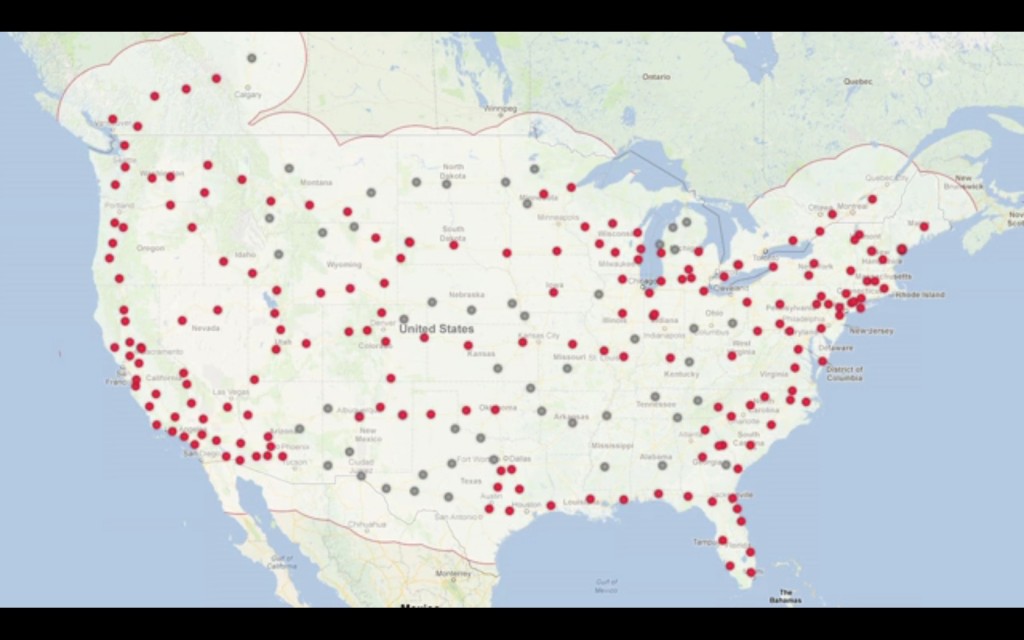Tesla Motors has surprised a lot of skeptics in its decade of existence.
But last month's announcement of battery swapping for Model S cars traveling long distances deserves some additional context.
It adds a new and quicker way for some Model S drivers to cover distances beyond the battery range of their cars, for sure.
ZEV credits
But it's also a way for Tesla to maximize the California zero-emission vehicle credits it earns for each Model S it sells.
In the first quarter of this year, those credits made the difference between profit and loss for Tesla Motors [NSDQ:TSLA].
While Tesla CEO Elon Musk says Tesla is assuming that revenue from sales of ZEV credits falls to zero by the end of this year, the company certainly won't turn down such sales if they occur.

Tesla Motors Supercharger Network In 2015 - released May 2013
And the ability to swap batteries--designed into the Model S from the start--lets Tesla earn the maximum number per car under the existing rules.
"Fast refueling" important
Under the somewhat arcane rules governing how ZEV credits are awarded, fast "refueling" turns out to count for a lot.
This likely dates back to the days when fleets of zero-emission hydrogen fuel-cell vehicles were envisioned by California regulators, all refueled similarly to gasoline cars at newly built hydrogen fueling stations.
On page 16 of a 36-page Final Regulation Order titled "Zero Emission Vehicle Regulation: 2009 through 2017 Model Years," the rules governing "fast refueling" for 2009 through 2017 vehicles are spelled out.
Maximum credits are awarded to vehicles that can "accumulate at least 190 or 285 miles, respectively, in 15 minutes or less."
Even the upgraded Tesla Supercharger quick-charging system can't quite hit that bar--so battery swapping comes into play.

Tesla Supercharger obelisk
Rule change proposed
However, as noted by Bloomberg and others, CARB is considering a rule change that could remove pack-swapping as an option for meeting the "fast refueling" requirement.
The proposed change would add a sentence reading, Range accumulation through battery exchange is ineligible for meeting “fast refueling capability.”
The Board held a workshop on May 20 to consider the proposal, but no rule changes have been issued thus far.
According to CARB's Anna Wong, the workshop on May 20 was well attended.
Comments this fall
The next step will be for the Board to release a Staff Report with the proposed changes in early September, Wong said.
That will "begin a 45-day public comment period" on the proposal, she said, after which, "we will take our proposal to the Board October 24 and 25."
"Members of the public are welcome to attend the hearing," according to Wong, "and make comments when [the] staff’s proposal is presented."
Will Tesla proceed?
If the proposal is adopted, we question whether Tesla will move ahead with its proposed network of swap stations located at some of its Supercharger quick-charging locations.
Tesla communications manager Shanna Hendriks avoided answering the question went sent her about whether the company would move ahead with its battery-swapping plans if the rule change were adopted.
She wrote:
Tesla's battery swapping is to provide consumers with a choice. It is a way to appease the consumers who think a free 30-minute stop at a Supercharger is still too long to make electric vehicles make sense.
Model S was designed and built since the beginning to have swapping capabilities. We will let our customers decide if they like the battery swap option or if free Supercharging is preferred.
_______________________________________________













